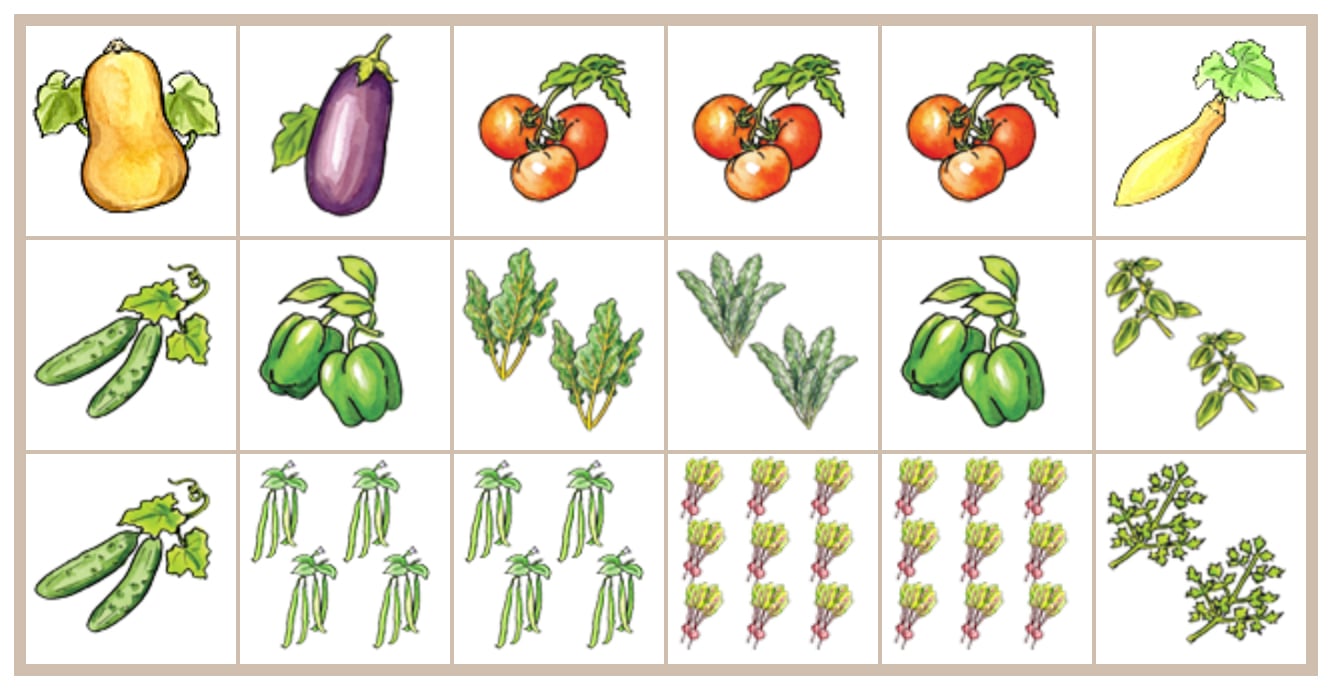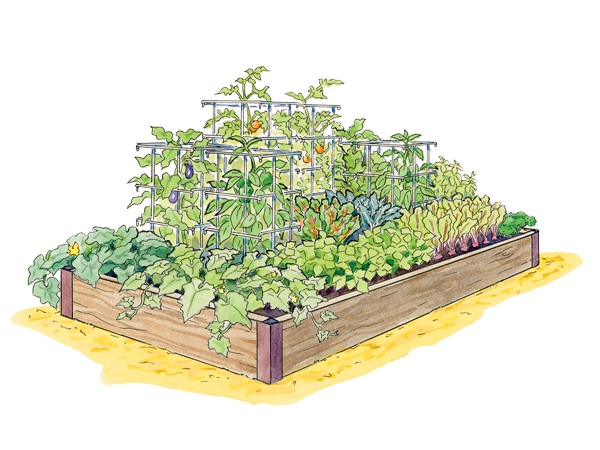High Yield

Planting Guide:
Winter squash
- There are many types, including butternut, acorn, sweet dumpling, hubbard and spaghetti squash.
- Plant seeds 3/4″ deep indoors or outdoors, three weeks after last frost, when soil is 70 degrees F.
- Transplant: three weeks after last frost, or when soil is 70 degrees F.
- Spacing: one plant per sq. ft. Grow on trellis or allow vines to run out of the garden
- Days to harvest: 85 to 100 from planting seeds, depending on variety. Pick before first frost.
- Hint: Prune growing tips to keep under control. Leave stems attached when harvesting.
Learn more about Winter squash in our Vegetable Encyclopedia
Eggplant
- Start seeds 1/4″ deep indoors eight weeks before last frost.
- Transplant seedlings when soil reaches 70 degrees F. or three weeks after last frost.
- Spacing: one per sq. ft.
- Days to harvest: 55 to 70 days from transplant. Not frost-hardy.
- Hints: Bugs love eggplants. Protect with garden fabric (row cover) even after flowering.
Tomato
- Plant seeds 1/4″ deep indoors, six to eight weeks before last frost
- Transplant into garden one to two weeks after last frost or when soil reaches 65 degrees F.
- Spacing: one plant per sq. ft. Grow early season crops nearby to allow more room later.
- Days to harvest: 55 to 100 days from transplanting, depending on variety. Not frost-hardy
- Hint: Remove lower leaves before planting and bury extra stem.
Summer squash
- Plant seeds 3/4″ deep indoors or outdoors three weeks after last frost, or when soil is 70 degrees F.
- Transplant three weeks after last frost, or when soil is 70 degrees F.
- When picked frequently, plants will produce continuously until frost.
- Spacing: one plant per sq. ft. for bush varieties; two plants per sq. ft. for vining types growing on trellis.
- Days to harvest: 30 to 40 days from transplant; 40 to 50 from seed. Not frost-hardy.
- Hint: Start under garden fabric (row covers) to protect from insects.
Learn more about Summer squash in our Vegetable Encyclopedia
Planting Guide:
Cucumber
- Plant seeds indoors 1/2″ deep three weeks before last frost, or seed in garden after frost.
- Transplant into garden after frost and when soil is 65 to 70 degrees F.
- Spacing one per sq. ft. for bush type; two per sq. ft. for vining type.
- Extend harvest with a second crop, planted two weeks later.
- Days to harvest: 50 to 60 days after transplanting. Not frost-hardy.
- Hint: Use row covers until flowering to keep off insects.
Peppers
- Start seeds indoors 1/4″ deep 10 to 12 weeks before last frost.
- Transplant into garden three weeks after last frost or when soil reaches 70 degrees F.
- Fruits are edible from early green to full-color maturity.
- Spacing: one plant per sq. ft.
- Days to harvest: 50 to 65 days green, 80 to 85 days to full color. Not frost-hardy.
Swiss chard
- Plant seeds 1/2″ deep indoors six weeks before last frost, or in garden two weeks before last frost
- Transplant: Around the time of last frost
- Plant a second crop to ensure a plentiful supply of tender leaves.
- Spacing: two plants per sq. ft.
- Days to harvest: 30 days from seed for baby; 50 days to full size. Frost-hardy.
- Hint: Good source of summer greens, chard is not bothered by heat.
Kale
- Sow seeds 1/2″ deep indoors eight weeks before last frost or in garden six weeks before last frost.
- Transplant seedlings into garden up to six weeks before last frost. Very frost-hardy.
- Spacing: two plants per sq. ft. Can be planted midsummer wherever early crops are removed.
- Kale continues to grow and produce leaves until late fall.
- Days to harvest: 60 days. Very frost-hardy.
- Hint: Kale can be grown in part shade. It needs plenty of moisture, so mulch well.
Basil
- Plant seeds 1/4″ deep indoors six weeks before last frost; outdoors two weeks after last frost.
- Transplant seedlings two to three weeks after last frost or when soil reaches 70 degrees F.
- Replant if you have space and want more.
- Spacing: two plants per sq. ft.
- Days to harvest: 40-55 days from transplant. Harvest leaves as desired. Not frost-hardy.
- Hint: Pinch stems early and often to stimulate branching and bushy growth.
Beans
- Sow seeds 1″ deep directly in garden after all danger of frost.
- Spacing: four plants per sq. ft. for bush beans, six to eight plants per sq. ft. for pole beans
- Plant second crop of bush beans (if needed) two weeks after first planting
- Days to harvest: 50-80 days from seed, depending on variety. Not frost-hardy.
- Hint: Add a legume inoculant when planting to increase vigor and yield.
- Buy organic bean seeds
Beet
- Sow seeds 1/2″ deep directly in garden five to six weeks before last frost.
- Spacing: Plant seeds 18 per sq. ft., thin to nine plants
- Plant more in midsummer for a fall harvest
- Days to harvest: 45 to 60. Frost-hardy.
- Hint: The longer you wait to harvest, the bigger the beets. Tops and thinnings are flavorful. Beet greens also make a great "wrap" for grilled proteins and veggies.
Parsley
- Start seeds 1/4″ deep indoors 10 to 12 weeks before last frost.
- Transplant seedlings into garden up to a month before last frost.
- Spacing: two plants per sq. ft.
- Edible all summer and into winter.
- Biennial: plants will go to seed second year.
- Days to harvest: 75. Begin harvesting foliage at any time. Very frost-hardy.
- Hint: Parsley takes up to 21 days to germinate. Treat seeds with hot water before planting.

